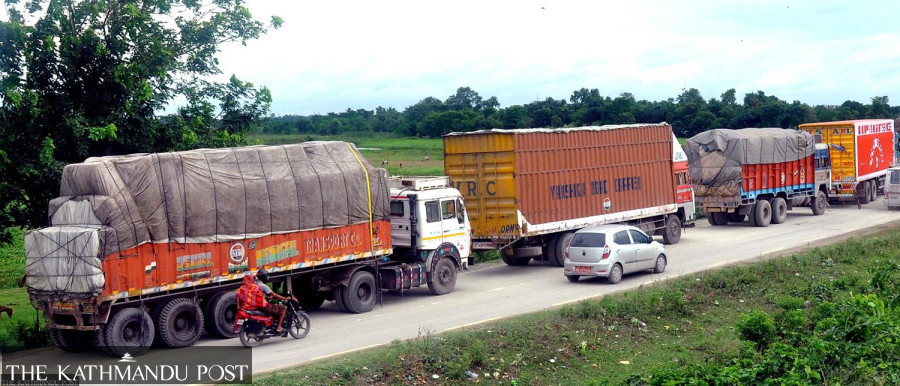Money
Nepal faces inflation risk from Red Sea disruption
The country is heavily reliant on imports from India, which is already experiencing soaring shipping expenses.
Krishana Prasain
Escalating tensions in the Red Sea due to attacks by the Houthi rebels, according to reports, may hit South Asian economies, including Nepal.
Experts say that Nepal, an import-driven economy, may see the impacts in two ways.
First, rising shipping costs to export goods.
Second, as Nepal’s imports are dependent on India, and as the southern neighbour is already experiencing increased expenses for ships, there will be a shared burden of the rising costs.
Paras Kharel, executive director of South Asia Watch on Trade, Economies and Environment (SAWTEE), a Kathmandu-based think tank, said as a quarter of Nepal’s exports go to the EU and the US markets, the Red Sea crisis could increase freight costs for Nepali exporters.
On November 19, 2023, Houthi rebels seized a ship named Galaxy Leader in the Red Sea. The rebels use drones and missiles to carry out attacks on commercial ships.
Backed by Iran, the Houthis have been targeting ships in the sea as a show of solidarity with Hamas. They consider ships passing through the Red Sea as supportive of Israel.
Media reports said that given the ongoing Israel-Hamas conflict, the rebels have vowed to continue attacking ships in the sea until Israel ceases its actions against Hamas. The Houthis have been attempting to disrupt international trade, which relies heavily on the vital maritime route.
It is much easier to reach Europe through the Suez Canal, one of the most important global choke points and maritime passages. It enables the transit of energy, commodities, consumer goods and components to and from the Indian Ocean and to the Mediterranean and the Atlantic.
“A quarter of Nepal's exports are bound for Europe, including Turkey, and the US through the Suez Canal,” said Kharel.
He said a change in the route could affect the freight prices and time for both imports and exports.
For instance, crude sunflower oil, a key import from Ukraine, could get expensive, he said.
Reports say rising shipping costs impact import costs in India, especially in sectors such as leather, plastics, and spices. The prices of major export items like Basmati rice are also on the up.
Nearly 20 percent of India’s trade takes place through the Suez Canal. So India, Nepal’s key trading partner, may face challenges while importing oil from West Asia and Russia.
A change in the route could affect the prices of 40 percent of oil imported from Russia via the Suez Canal.
Shipping costs may increase up to 40 percent, affecting Indian exports and causing losses for companies exporting abroad.
The rise in the prices of goods in India means Nepal too will have to share the burden.
According to a report entitled, ‘Red Sea Attacks Monitor: South Asia Highly Vulnerable To Disruptions’ by Fitch Solutions, which provides ‘insights, data and analysis’, attacks by the Iran-backed Houthi rebel organisation on commercial vessels in the Red Sea have persisted into February this year.
This increases the risk of the crisis impacting economic growth and inflation across Asia, with an upside shock on oil prices.
The report published on February 19 said that the Red Sea is a key maritime shipping route linked directly to the Suez Canal, which substantially reduces the maritime trade distance between Europe and Asia and carries a significant 12 percent of global trade.
“The closer the Suez Canal to an Asian economy is, the larger the relative increase in trade distance will be as a result of closure. This will in turn cause a bigger rise in shipping costs and time and a larger decrease in trade volume.”
“Therefore, South Asia would be the worst hit,” the report said.
According to the Department of Customs, Nepal imported goods worth Rs1.61 trillion and exported goods worth Rs157.14 billion in the last fiscal year, ending mid-July 2023.
Kharel said that if the disruption to the Red Sea route continues, there may be ripple effects—further squeezing Nepal’s economy due to imported inflation.
The current crisis is disrupting shipments of grains and other key commodities from Europe, Russia, and Ukraine.
“This can raise the costs of imported products for consumers and lower prices paid to producers—posing risks to already precarious food security in some countries, particularly those dependent on food imports,” according to the Fitch Solution report.
The Red Sea crisis is largely affecting cargo moving on routes between Asia and Europe, which has the potential to disrupt supply chains of industries, such as construction, automotive, chemicals and machinery that rely on intermediate imports from the Asia–Pacific region, said another report by the United Nations Conference on Trade and Development (UNCTAD).
In February, the impact on bulk freight rates was mixed, with tanker rates rising sharply over the second half of January, while dry bulk, liquified natural gas and liquified petroleum gas freight rates were less affected, according to the UNCTAD report.
Container rates on Asia-Pacific to Europe routes have increased significantly since November last year. In the last week of December 2023, average container spot freight rates surged by $500, it said. “This was the highest-ever weekly increase.”




 7.12°C Kathmandu
7.12°C Kathmandu













%20(1).jpg&w=300&height=200)
